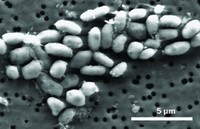Advertisement
Grab your lab coat. Let's get started
Welcome!
Welcome!
Create an account below to get 6 C&EN articles per month, receive newsletters and more - all free.
It seems this is your first time logging in online. Please enter the following information to continue.
As an ACS member you automatically get access to this site. All we need is few more details to create your reading experience.
Not you? Sign in with a different account.
Not you? Sign in with a different account.
ERROR 1
ERROR 1
ERROR 2
ERROR 2
ERROR 2
ERROR 2
ERROR 2
Password and Confirm password must match.
If you have an ACS member number, please enter it here so we can link this account to your membership. (optional)
ERROR 2
ACS values your privacy. By submitting your information, you are gaining access to C&EN and subscribing to our weekly newsletter. We use the information you provide to make your reading experience better, and we will never sell your data to third party members.
Biological Chemistry
Arsenic Bacterium Debate Continues
Research: Science publishes rebuttals to a sensational claim about DNA biochemistry
by Elizabeth K. Wilson
June 6, 2011
| A version of this story appeared in
Volume 89, Issue 23

A volley of criticism against a claim that a certain extremophile bacterium from arsenic-rich Mono Lake in California incorporates arsenic into its DNA backbone was published in the June 3 issue of Science, (2011, 332, 1149). The claim, if true, would alter the fundamental understanding of carbon-based life and opens a wider window to the possibilities for extraterrestrial life.
The original work, by astrobiologist Felisa Wolfe-Simon and colleagues, was published online in Science in December 2010 (C&EN, Dec. 13, 2010, page 7). The original paper also appears in the June 3 issue of Science. The published criticisms—a series of so-called technical comments—echo the chorus of skepticism from experts in origin-of-life science and DNA biochemistry that greeted the original claim.
In his technical comment, for example, synthetic biology pioneer Steven A. Benner at the Foundation for Applied Molecular Evolution argues that arsenate esters, the chemicals that supposedly form in the DNA backbone in place of phosphate esters, fall apart within minutes of exposure to water.
Wolfe-Simon’s group counters that it’s possible that steric hindrance could prevent water from attacking arsenate, thus allowing it to exist within DNA strands. The group’s response to all of the technical comments also appears in Science’s June 3 issue and includes a more detailed explanation of their methods (DOI: 10.1126/science.1202098). They note that they are making samples of the bacterium in question available to scientists who wish to test their hypothesis.
“We hope that publication of this collection will allow readers to better assess the research article’s original claims and the criticisms of them,” says Science Editor-in-Chief Bruce Alberts in a letter introducing the technical comments.
Still, “the Wolfe-Simon paper is unlikely to withstand the close scrutiny it is now beginning to receive,” says leading origin-of-life expert Gerald F. Joyce of Scripps Research Institute, who is not one of the commenters. “This is not an embarrassment for the field if everyone plays their roles with dispassion and scientific objectivity.”
Wolfe-Simon, who works at NASA’s Astrobiology Institute and the U.S. Geological Survey in Menlo Park, Calif., tells C&EN she thinks the controversy has primed the scientific process. “We’ve been able to gain so much because of discussion and collaboration,” she says. “This is moving science forward faster.”
For the original work, Wolfe-Simon and colleagues collected bacterial samples from the lake. They fed the bacteria a diet of arsenic, which should have killed them, yet the organisms continued to grow. The group performed a battery of tests, including X-ray absorption studies and mass spectrometry, which the researchers said indicated that the bacteria not only had internalized the arsenic but had weaved the element into the backbone of their DNA, in place of phosphorus.
But many researchers, including those who wrote the technical comments, say that none of these tests prove that the bacterial DNA incorporates arsenic. In fact, some say, the arsenic-fed bacteria were able to subsist on small amounts of phosphorus that contaminated the experiment.
Jack W. Szostak, an origin-of-life expert from Harvard Medical School, welcomes the debate. “I think it’s clear that the scientific enterprise in general is working the way it should. When flawed work is published, other scientists dispute the findings, ultimately more experiments are done, and we converge on the correct explanations for the issue at hand,” he says. “The only real issue remaining is how such a deeply flawed paper could be published in Science in the first place.”





Join the conversation
Contact the reporter
Submit a Letter to the Editor for publication
Engage with us on Twitter